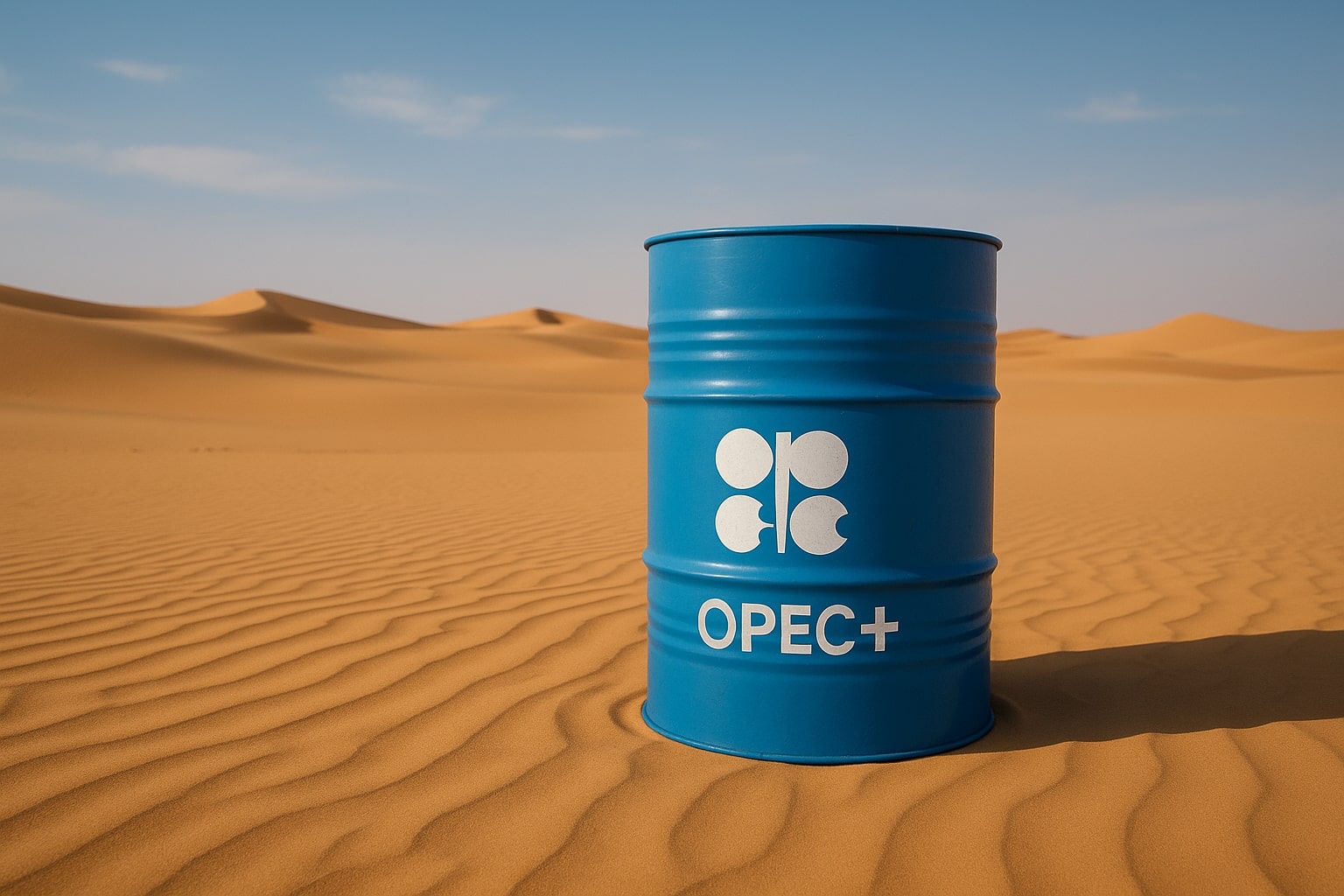
Oil Price Forecast: WTI at $62.69, Brent at $66.99 as Supply Builds and Risks Mount
OPEC+ supply growth, U.S. output gains, and Saudi discounts pressure prices while Russia-Ukraine conflict and Middle East tensions drive volatility | That's TradingNEWS
WTI (CL=F) and Brent (BZ=F) Under Geopolitical and Supply Pressure
Oil markets ended the week with volatility driven by geopolitical conflict, sanctions risk, and shifting demand expectations. WTI crude (CL=F) closed at $62.69 per barrel, up 0.51%, while Brent (BZ=F) finished at $66.99, advancing 0.93%. The modest recovery came after Thursday’s slide, when both benchmarks lost close to 2% on soft U.S. demand data. This rebound was largely fueled by a Ukrainian drone strike on Russia’s Primorsk port, one of the country’s largest oil export terminals, which forced a temporary halt in loading operations and added new concerns over supply disruption. The attack coincided with renewed Kremlin announcements suspending peace talks, raising fears that sanctions could intensify, especially as Washington and Brussels weigh broader measures against Russian crude and refined product flows.
Supply Growth and Oversupply Concerns
Despite these geopolitical shocks, underlying fundamentals still point to a fragile balance. The International Energy Agency (IEA) confirmed global oil supply is set to grow faster than expected this year, driven primarily by OPEC+ capacity increases. The U.S. is also contributing, with the latest EIA report showing weekly U.S. crude production rising to 13.495 million barrels per day, a gain of 72,000 bpd from the previous week. Rig activity has shown a mild uptick, with Baker Hughes reporting the oil rig count climbing by two to 416, though this is still 72 rigs lower year over year. The rebound in supply coincides with weak consumption in the U.S. gasoline market, where gasoline futures barely moved at $1.985/gal, reflecting sluggish demand even as refineries process near record volumes.
Saudi Discounts, Asian Demand, and India’s Strategic Moves
OPEC members continue to compete aggressively in Asia. Saudi Arabia deepened discounts to Chinese buyers for October cargoes, a move designed to protect market share as Russian barrels flow at lower costs despite sanctions. Reports confirm Saudi sales to China are set for an October jump, even as state-run producers cut prices. Meanwhile, India remains the largest buyer of Russian seaborne crude, with recent moves by Adani Ports to block Western-sanctioned tankers signaling more selective sourcing. India is also preparing new carbon capture incentives to balance rising coal consumption, underscoring its energy security priority over climate commitments. These shifts reveal how Asia’s energy giants are both beneficiaries of discounted Russian oil and price-setters in today’s market.
Russia’s Strain and Revenue Collapse
While Russia continues to move barrels east, revenues have collapsed. August crude and refined product income fell to multi-year lows under the weight of sanctions and shipping restrictions. With European deadlines set to phase out Russian energy imports fully by 2028, and Trump calling on the G7 to consider tariffs against both China and India for Russian imports, the pressure on Moscow’s fiscal health is building. This dynamic has increased reliance on smaller Asian refiners and gray fleet shipping, both of which carry rising costs and risks of disruption. Russia’s ability to maintain production near 10.8 million bpd is being tested against shrinking cash flows, which could force deeper discounts or curtailments if sanctions tighten further.
Middle East Conflict and Tariff Risks
The geopolitical premium resurfaced after Israel launched strikes on targets in Qatar, escalating Middle Eastern tensions and pushing oil benchmarks temporarily higher. At the same time, the Trump administration’s tariff threats against China and India have injected another uncertainty, with markets weighing the risk of retaliatory demand cuts. These measures, if enacted, could limit the very Asian demand that underpins the oil market’s resilience. Traders are increasingly cautious as oil remains capped in the mid-$60s despite ongoing conflicts, suggesting that structural oversupply outweighs geopolitical spikes in the short term.
Read More
-
UCO ETF Price Forecast: Can NYSEARCA:UCO at $18.57 Ride a 2026 Oil Squeeze?
18.12.2025 · TradingNEWS ArchiveStocks
-
XRPI at $10.50 and XRPR at $14.93 Hit XRP ETF Lows While XRP-USD Holds $1.84 After 30 Days of Inflows
18.12.2025 · TradingNEWS ArchiveCrypto
-
Natural Gas Price Forecast: Henry Hub Holds Around $4 as EIA Draw Hits 167 Bcf
18.12.2025 · TradingNEWS ArchiveCommodities
-
USD/JPY Price Forecast: Pair Holds Above 155 As BoJ And US CPI Set Up A Major Break
18.12.2025 · TradingNEWS ArchiveForex
Corporate Positioning: BP and Supermajors
On the corporate side, BP (LSE:BP, NYSE:BP) has been quietly rebuilding momentum. Shares gained 28% since April, trading near 500p, helped by the company’s largest Brazilian discovery in 25 years and a new exploration pact with Egypt. BP targets production of 2.3–2.5 million boe/day by 2030, supported by a three-year LNG deal with Turkey’s BOTAS. With a forward P/E of 12.68 and projected earnings growth of 28.3% annually, BP appears undervalued by up to 52% on forecast cash flows. Its dividend yield remains 5.8%, with guidance to rise above 6% by 2026, keeping income investors engaged. Still, oil price volatility and high-cost exploration risks limit the upside, particularly if Brent remains stuck below $70. The BP recovery highlights how supermajors are pivoting back toward hydrocarbons to secure cash flow, even while scaling back renewable spending.
Technical Landscape for WTI and Brent
From a technical perspective, WTI (CL=F) faces firm resistance at $63.50–$64.00, a zone repeatedly rejecting rallies this summer. Support remains near $61.00, and a break below risks a slide toward $58.00, levels last seen in early 2023. Brent (BZ=F) holds stronger relative strength, consolidating above $66.50, but a sustained break above $68.50 is required to challenge the $70 psychological barrier. Indicators show momentum stabilizing, with RSI for both contracts near neutral levels, but volume remains thin—suggesting traders are reluctant to build large positions without a clearer macro signal.
Buy, Sell, or Hold Verdict
With WTI at $62.69 and Brent at $66.99, the market is caught between geopolitical premiums and oversupply realities. Rising U.S. output, OPEC+ capacity expansion, and weak U.S. demand argue for bearish pressure, while Russia-Ukraine conflict risks and Middle East instability provide only temporary spikes. For traders, this creates a choppy market with limited upside beyond $70 Brent in the near term. BP’s fundamentals show selective opportunity among supermajors, but the broader oil complex remains under pressure. Based on the data, the oil market leans toward a Hold with a bearish tilt, with better entry points likely if WTI dips below $60 and Brent retests $64.



















